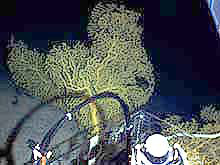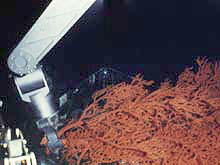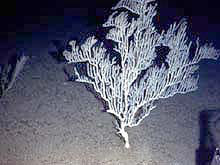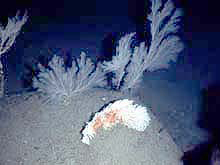
This deep water “gold coral”, collected in Hawaii, has a "skeleton" made of very dense and degradation-resistant protein. These corals appear to grow very slowly perhaps over several centuries or longer. (Image courtesy of Rob Dunbar) Click image for larger view.
Dispersal and Reproductive Biology of Deep-Sea Corals
Amy Baco-Taylor
Woods Hole Oceanographic Institution
Seamounts are a unique type of deep-sea habitat that remain relatively unexplored. Seamount benthic habitats (on the bottom) can be quite isolated, being the only hard bottom for miles around in the vast water column. This isolation is further enhanced by the specialized current flows around seamounts that may help retain larvae, which are baby marine organisms, on or near the seamount. Because of the extreme isolation of seamount habitats, they represent potential hotspots for the creation of new species. Not surprisingly, scientists have found that many of the species on a given seamount may be endemic – found only on that seamount.
Coral Dispersal

This is the Hawaiian "black coral", another proteinaceous species. Antipathes is harvested commercially, as a source of raw material to produce carvings, statues, and jewelery. The sustainability of this type of fishery is very much dependent on a balance between harvest rates and growth rates of the coral - about which we currently know very little. (Image courtesy of Rob Dunbar) Click image for larger view.
The benthic fauna (those living on the bottom) of seamounts can be quite diverse. (Read a related essay from the exploration of Davidson Seamount). However the dominant faunal group on most Pacific seamounts are gorgonian (sea fan type) corals. To determine how well populations of benthic invertebrates disperse between seamounts, we will sample these deep-water gorgonian corals from each seamount.
The more traditional methods of determining dispersal in marine organisms, e.g. mark and recapture studies, are difficult or impossible to use for deep-sea organisms. Instead, we will use population genetics to infer dispersal of the coral species between different seamounts. Population genetics involves isolating DNA from coral tissues and then looking at the levels of variation in the sequences of the genes between different individuals. If there is a lot of similarity in gene sequences between seamounts, this implies the corals are dispersing well between them. If there is little similarity, it implies the coral populations on different seamounts are isolated from each other.
Reproductive Biology

This branching or “bamboo” coral has parts composed of both protein (the black parts) and calcium carbonate (calcite - the white parts). Click image for larger view.
Marine organisms employ different types of dispersal mechanisms. Some species reproduce by broadcasting their gametes (eggs and sperm) into the water column and thus tend to be capable of long distance-dispersal. Other species brood their larvae and the young only swim a short distance or may even crawl from the parent and settle just a few feet away. The brooders tend to have short-distance dispersal capabilities. We will collect samples to begin to determine whether these corals are long- or short-distance dispersers. One clue to this is the number of eggs forming inside the polyps. Broadcasters tend to have large numbers of small eggs and brooders tend to have small numbers of large eggs. By making super-thin sections of the coral tissues, we will be able to determine the number and size of eggs in each polyp.
Why?

Corallium secundum is the deepwater Hawaiian "pink coral". Individual colonies like these may take 30 to 70 years to grow. They filter food from the water column but their carbonate skeletons record the chemistry and temperature of the deep water. (Image courtesy of Rob Dunbar) Click image for larger view.
Corals are the dominant taxa on most seamounts. Most seamounts lie in international waters and are therefore not protected from exploitation. In some parts of the world, certain types of deep-water corals are collected, using destructive fishing methods, and used in the jewelry industry. Also some fisheries, e.g. the orange roughy fishery, use trawls to collect fishes associated with seamounts. These fishes are collected using large trawls which essentially scrape all of the fauna off of the seamount. Because of the threats to deep-water corals and other seamount fauna, it is important to begin to understand more about their ecology so seamount fauna can be more effectively managed and protected.
Sign up for the Ocean Explorer E-mail Update List.


























